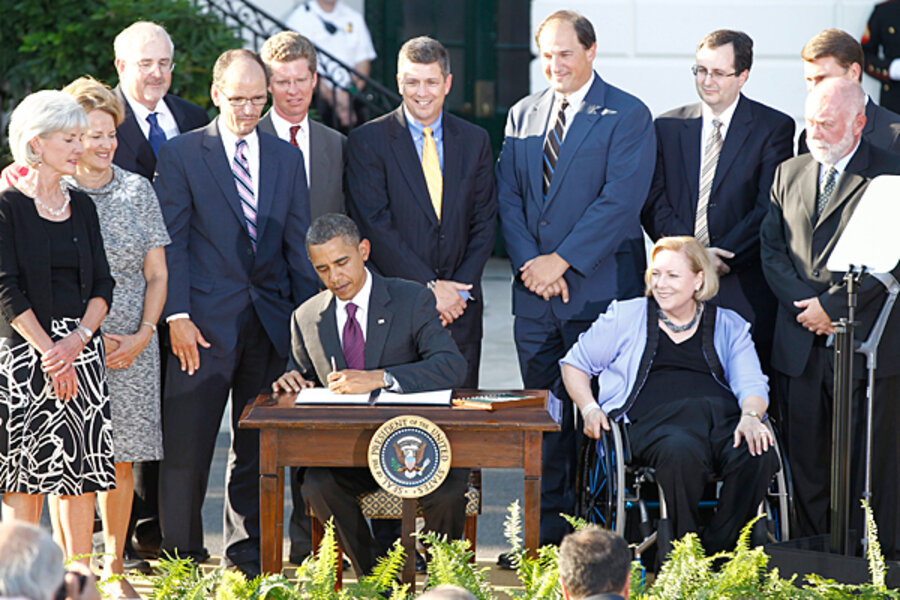ADA at 20: breakthroughs abound, but some attitudes unchanged
Loading...
Monday marks the 20th anniversary of President George H. W. Bush signing the Americans with Disabilities Act (ADA) into law and proclaiming, “Let the shameful walls of exclusion finally come tumbling down.”
As President Obama celebrates the milestone on the South Lawn Monday afternoon, officials, advocacy groups, and the public are applauding how transformational the law has been for tens of millions of Americans with disabilities. In its 20 years, the law has made buildings, vehicles, and streets more accessible, yet many say much more can be done to end discrimination for those with a physical impairment.
“Twenty years after the passage of the Americans with Disabilities Act, we can see tangible results,” says James Weisman, senior vice president and general counsel for the United Spinal Association, which advocated for and drafted significant provisions for the legislation.
“The ADA mandates have broken down architectural, transportation and communication barriers,” adds Mr. Weisman. “The opportunity, which has afforded those with physical, sensory and cognitive impairments the enjoyment of all America has to offer, has changed us all. The accommodation of people with disabilities has made us a world model.”
The ADA is a broad civil rights law that forbids discrimination based on disability. It gives similar protections against discrimination to Americans with disabilities as the Civil Rights Act of 1964, which made illegal any discrimination based on race, religion, sex, national origin and other characteristics.
Iowa Sen. Tom Harkin (R), in an op-ed for Politico, recalls hearings before the law's passage:
"We heard stories of Americans who had to crawl on their hands and knees to go up a flight of stairs, or to gain access to their local swimming pool; who couldn’t ride on a bus because there wasn’t a lift; who couldn’t go to concerts or ballgames because there was no accessible seating; who couldn’t cross the street in wheelchairs because there were no curb cuts…. Twenty years later, that wall is indeed falling.”
“How soon we forget the pre-ADA America," writes Senator Harkin.
Despite the ADA's success, the US still has barriers to break down, say Weisman and others.
“Legislation invites interpretation,” says Robin Bond of Transition Strategies, LLC, an employment law firm. She says that while the ADA has raised the level of awareness about disabled workers, and provided “more legal safeguards for the disabled than people originally thought it would" over the last 20 years, there are troubling trends.
That interpretation can lead to inconsistencies for many workers with disabilities, says Ms. Bond. "How successful a disabled worker is at staying employed is more often determined by the sensitivity of the boss, and the culture the employer adopts,” she says.
Moral and attitudinal shifts need to follow the ADA's legal strides, say several experts.
“The public doesn’t really have an appreciation for what it means to be disabled,” says Dr. Suzanne Smeltzer, professor in the college of nursing at Villanova University. “People need to be more aware of the gigantic contributions these people are making to society, that they are not a drain on the system – they are raising families and taking care of children and parents while holding very responsible positions," she says. "That is still not a view that many in society have.” [Editor's note: The original misspelled Dr. Smeltzer's name.]
Bond, a workplace legal expert who represented employers for 15 years before representing employees for the past 13, says the discrimination against the disabled still exists but now takes subtler – even “sneakier” forms.
“Employers realize that with the law, they can’t be overt about simply firing someone, so they figure out ways of restructuring and reconfiguring their organizations to get rid of these people in a less blatant way.”
Weisman laments the fact that just like 20 years ago, 65 percent of those with disabilities are unemployed. But he and others point out that those numbers are skewed by medical advances and extended lifespans; there are now many more disabled people around.
One key element in expanding opportunities for people with disabilities' is technology. The Internet and improvements in assistive devices make it a very exciting time for the disabled rights movement, says Elizabeth Pendo, at professor St. Louis University School of Law.
“The promise of technology is exciting because it harbingers what ADA has strived for since the beginning, which is fuller participation in society.”
Related:





